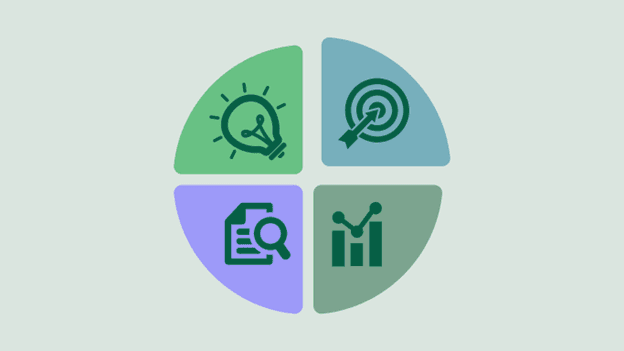Although the terms “tactics” and “strategy” are often used interchangeably, they hold distinct meanings, not least in the world of Industrial DataOps.
Tactics refer to the immediate actions necessary for day-to-day management, such as data collection and basic reporting. These are essential for maintaining current operations and addressing immediate needs.
Strategy, on the other hand, involves long-term planning aimed at achieving broader business goals. It focuses on leveraging data as a strategic asset, setting clear objectives, and deploying resources to build robust data infrastructures and governance systems. This approach ensures sustained growth and innovation.
Litmus helps organizations transition from relying on short-term tactical fixes to adopting strategic, structured approaches that maximize the utility of their data. By integrating tactics into a comprehensive strategy, Litmus’s approach to Industrial DataOps not only meets current demands but also sets the stage for future expansion and more advanced data analysis.
Understanding DataOps: Beyond Data Collection
DataOps is not just about collecting data. The real value is in strategically using this data to drive continuous improvement and innovation within industrial operations. This enhanced approach moves beyond the traditional scope of simple data collection by integrating continuous feedback loops, analysis, and deployment into every stage of the operational process.
As organizations implement their Industrial DataOps strategy, they begin with data collection, but quickly shift to a more dynamic interaction where data is not only gathered but also analyzed and applied in real-time.
This continuous cycle of development, combined with the real-time application of insights, transforms operations from static to adaptive, helping businesses respond more swiftly and effectively to changes and new opportunities.
The Strategic Shift: Leveraging Cloud Technologies
In the movement towards strategic data operations, cloud technologies like Google Cloud, AWS, Cloudera, and Microsoft Azure are pivotal. These platforms enhance data operations by automating the integration, cleaning, and processing of data, significantly reducing the time spent on these tasks—by as much as 75%. This efficiency allows companies to concentrate more on analysis and decision-making.
The cloud supports the centralization of data from diverse locations, offering a unified view that facilitates direct comparisons and thorough analysis. Companies can evaluate productivity across different plants to pinpoint inefficiencies or successful strategies that might be replicated.
This centralization not only simplifies data management but also transforms data into a dynamic asset that propels operational improvements and strategic insights.
Centralized Data Governance
Centralized data governance is also integral to maintaining data integrity and consistency within an organization. By leveraging cloud-based systems for data storage and management, businesses ensure a cohesive approach to handling their data. This centralized governance framework allows for uniform data practices across all operations, enhancing the quality and replicability of processes. It also supports compliance and standardization, which are essential for effective strategic planning and operational analysis.
“Effective data governance ensures uniformity across all data, enabling scalable and replicable system applications.” — Dave McMorran
This approach allows companies to conduct comprehensive analyses that yield strategic insights, helping to identify operational efficiencies and inefficiencies. With centralized data governance, businesses are better equipped to make informed decisions that drive success and adapt to new challenges efficiently.
DataOps in Action
Industrial DataOps plays a crucial role in enhancing operational efficiency and fostering a culture of continuous improvement within organizations. By incorporating DataOps practices alongside established methodologies like Kaizen, companies are able to harness and utilize their data more effectively.
This strategic deployment of data not only facilitates immediate operational adjustments but also paves the way for sustained advancements and innovation.
“Our application is dynamic, designed for continuous evolution, unlike a static SCADA system that’s built for a specific purpose.” — Dave McMorran
Implementation Example
One practical application of Industrial DataOps is seen in how companies integrate real-time data analysis into their operations. For instance, a manufacturing firm might use sensors and data analytics to monitor production lines continuously. This setup allows them to detect inefficiencies or breakdowns instantly and respond swiftly, thereby reducing downtime and increasing productivity.
Strategic Impact
Furthermore, this proactive use of data supports long-term strategic planning. Through continuous monitoring and analysis, businesses can identify trends and patterns that inform future investments in technology and infrastructure improvements. DataOps thus becomes integral to both day-to-day management and strategic decision-making, ensuring that businesses remain agile and competitive in a fast-evolving marketplace.
Summary
“It’s like having a continuous improvement manager supercharged with data, not just for collection but to enhance daily operations.” – Marc Dekker
The strategic adoption of DataOps marks a sea change in how data is perceived and utilized across industries. Moving beyond just data collection to a comprehensive and insightful integration, organizations can unlock significant improvements in decision-making and operational efficiency.
This evolution in DataOps signifies a wider trend towards data-driven approaches, underscoring data’s vital role as a competitive asset. By leveraging real-time data analysis and continuous improvement practices, businesses not only address immediate operational challenges but also set the stage for long-term innovation and success in a dynamic market.
This shift doesn’t just change the operational landscape—it sets a new standard for using data strategically in business.
For a deeper understanding of how to move from tactical to strategic data management, check out this enlightening conversation between Dave McMorran, our Director of Sales Engineering, and Marc Dekker, our VP of Customer Success.



